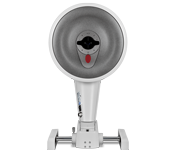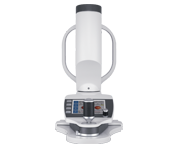 Topography and Dry Eye Analysis
Topography and Dry Eye Analysis  Anterior Segment Analysis
Anterior Segment Analysis  Slit Lamp / Documentation
Slit Lamp / Documentation  Myopia Management
Myopia Management  Perimetry
Perimetry  Tonometer
Tonometer  Visual Test Equipment
Visual Test Equipment  Vitreoretinal Surgery
Vitreoretinal Surgery  Manual Refraction
Manual Refraction 


Subjective refraction is even simpler and more comfortable with the OCULUS Universal Trial Frame UB 3+ – a real step forward for refractionists and clients alike. Not only is the UB 3+ exceptionally lightweight; all of its operating elements have been ergonomically shaped, and every detail designed with functionality in mind.
The new Universal Trial Frame has a chic and modern appearance, further emphasizing the skill of the refractionist. One thing will never change though, and that’s OCULUS’ signature quality. The OCULUS UB 3+ is also 100% made in Germany. All 218 individual components are assembled by hand so that every tiny detail is perfect.




Can any trial lens be used in an OCULUS Universal Trial Frame?
Universal Trial Frames UB 3/UB 3+, UB 4 and UB 6 are all suitable for any trial lens conforming to DIN EN ISO 9801 and having a rim diameter of 38 mm, such as a OCULUS “tl” trial lens.
However, our Universal Trial Frame UB 5 for small heads requires trial lenses of the “tls” line with a diameter of 28 mm. These also conform to DIN EN ISO 9801 and are available nowhere in the world but from OCULUS.
Is the UB 5 only suitable for children?
The UB 5 was developed for small heads, which means that it will fit many adults as well, especially among the elderly. It has a PD range of 40-72 mm. In order to achieve such low PD values without changing the lens diameter (21 mm) it was necessary to reduce the rim diameter. That’s the simple idea behind the OCULUS UB 5: It’s ideally suited for small heads including those of children.
The UB 6 is the latest OCULUS Universal Trial Frame Model. How does it differ from earlier models?
The UB 6 stands out for its trendy, modern design. The nose pad has been improved for better pressure distribution as well as in terms of adjustability. In addition, the front lens holder now offers four instead of the usual 3 slots, while the rear lens holder accommodates two lenses, as before.
Unique to the design of the UB 6 is the gradation of the scale for reading off the axis and base position, which is now in steps of 2.5°, allowing for greater reading accuracy. The operating elements now have an attractive conical design and are grooved to provide a better grip. Their somewhat harder material makes them more durable than those of earlier models.
The aluminium scales are absolutely abrasion-proof. Their high contrast makes for easy reading also in darkened rooms. The upward angled operating element for precise nose pad adjustment has been designed for easy use outside the test person’s field of view.
The flexible arms adapt to the shape of the ears and do not need to be adjusted.
All modifications and improvements were made in response to customer requests.
Are there spare parts available for these trial frames?
Yes, all spare parts are available. Please contact the distributor from whom you bought your trial frame.
Are OCULUS Universal Trial Frames manufactured by hand?
Yes, all components of every one of our Universal Trial Frames are assembled manually with great precision. Here too, we stay true to our quality claim: Made in Germany – made by OCULUS.
Are there polarizing filter available for every Universal Trial Frame?
Yes, polarizing filters are always optionally available. Those for the UB 6 have a clip for easy mounting, while those for the UB 4 and UB 5 are to be directly slipped onto the trial frame.
Polarizing filters with a clip as well as those of the slip-on type are for lateral mounting and can be easily flipped to the side when not needed.
On the UB 3/UB 3+ the polarizing filter has a central mount and can be simply removed after use. All linear polarizing filters are reversible.
Circular polarizing filters are available both with a clip and in a slip-on version.
There are also circular polarizing filters available in trial lens size for use in a slot of the rear lens holder if one should be free.
Why are there two different set positions for mounting polarizing filters on the UB 4 and the UB 5?
To mount the polarizing filter, insert the pin of the filter into the transverse borehole in the trial frame and push the pin in until it locks into the place the first time. This is the top position, and it is used for testing distance vision. To test near vision, push the polarizing filter all the way down until it locks into place in the bottom position. This procedure is also described in the instructions for use delivered with the polarizing filters.
How can I clean my Universal Trial Frames?
If necessary we recommend cleaning your trial frames with a soft lint-free cloth only. To clean a heavily soiled trial frame you can use a damp cloth and a little household dishing-washing liquid. Never use alcohol, ether or similar solvents, let alone aggressive chlorinated, scouring or corrosive detergents.
For disinfection we recommend disinfection cloths such as Pursept®-A Xpress or Mikrozid® Sensitive Wipes from Schülke und Mayr GmbH. Please contact your OCULUS distributor so that they can order through OCULUS, or contact the source supplier directly: www.schuelke.com.
In which trial frame is it possible to lock the nose pad at the desired height?
The UB 5. Use the operating element (knob) to set the nose pad to the desired height, then pull the knob out slightly. This locks the nose pad at the set height.
Does the scale on OCULUS Universal Trial Frames for reading the axis and base position conform to the TABO graduated arc scale according to DIN EN ISO 8429?
Yes, it conforms to DIN EN ISO 8429.
What warranty is there for OCULUS Universal Trial Frames?
The warranty period is one year from delivery, or from acceptance, if acceptance is required.
How can I adjust the resistance of the nose rack and nose pad on the UB 4 and UB 6?
The UB 4 has a small Phillips screw for adjusting the resistance. The UB 6 has instead a small hexagon socket screw for this purpose (hexagon screwdriver included in delivery).
In what kind of packaging are OCULUS Universal Trial Frames delivered?
Universal Trial Frames UB 3+, UB 4, UB 5 and UB 6 are all delivered in a telescopic cardboard box.
This telescopic box has been designed so that it can be used for storing the trial frame in a drawer or together with the refraction unit. It is lined with hard-wearing PE foam to protect the trial frame.
Are OCULUS Universal Trial Frames latex-free?
Yes. None of the OCULUS Universal Trial Frames contains latex.
How many slots does each of the Universal Trial Frames have?
UB 3/UB 3+, UB 4 and UB 5: Three slots in the front lens holder and two in the rear lens holder on either side ⇒ 10 slots altogether
UB 6: Four slots in the front and two in the rear lens holder on either side ⇒ 12 slots altogether.
Do the operating elements of the UB 6 (knobs) also fit on the UB 4?
No, the operating elements differ in design, so they cannot be switched between the UB 6 and UB 4.
Do the operating elements of the UB 4 (knobs) also fit on the UB 6?
No, the operating elements differ in design, so they cannot be switched between the UB 4 and UB 6.
Do the arms of the UB 6 also fit on the UB 4?
No, the arms differ in design, so they cannot be switched between the UB 6 and UB 4.
Do the arms of the UB 4 also fit on the UB 6?
No, the arms differ in design, so they cannot be switched between the UB 4 and UB 6.
Do the end-pieces of the arms on the UB 6 also fit on those of the UB 4?
No, the end-pieces differ in design, so they cannot be switched between the UB 6 and UB 4.
Do the end-pieces of the arms on the UB 4 also fit on those of the UB 6?
No, the end-pieces differ in design, so they cannot be switched between the UB 4 and UB 6.
Does the nose rack of the UB 6 also fit on the UB 4?
No, the nose racks differ in design, so they cannot be switched between the UB 6 and UB 4.
Does the nose rack of the UB 4 also fit on the UB 6?
No, the nose racks differ in design, so they cannot be switched between the UB 4 and UB 6.
Does the polarizing filter of the UB 6 also fit on the UB 4?
No, each polarizing filter is fine-tuned to the design of the trial frame it is intended for, so it cannot be switched between the UB 6 and UB 4.
Does the polarizing filter of the UB 4 also fit on the UB 6?
No, each polarizing filter is fine-tuned to the design of the trial frame it is intended for, so it cannot be switched between the UB 4 and UB 6.
Does the nose pad of the UB 4 also fit on the UB 6 and vice versa?
Yes, the nose pads of these two models are interchangeable.
Does the lens holder of the UB 4 also fit on the UB 6 and vice versa?
No, each lens holder is designed to precisely match the trial frame it is intended for, so the lens holders cannot be switched between the UB 4 and UB 6.
Do the coloured operating elements of the UB 5 also fit on the UB 4?
Yes, provided that the UB 4 has round operating elements only. They do not fit on older UB 4 models that have conical operating elements for adjusting pupillary distance.
How many nose pads are delivered with the OCULUS Universal Trial Frames?
UB 6: four nose pads in total
UB 5: three nose pads in total
UB 4: three nose pads in total
UB 3+: two nose pads in total
Are the nose pads interchangeable within the OCULUS Universal Trial Frame family?
Yes, with the exception of the UB 3.
How much do the OCULUS Universal Trial Frames weigh?
UB 6: approx. 61 g
UB 5: approx. 48 g
UB 4: approx. 64 g
UB 3: approx. 58 g
UB 3+: approx. 52 g (10 % lighter than the UB 3)
note: specifications are subject to change!
How can I read the current vertex distance (VD) free of parallax?
The transparent sighting bar has one scale on its surface and one inside. Take your VD reading when you see the two scales in alignment. The millimetre values on the scale refer to the eye-side vertex of a trial lens located in the first slot of the rear lens holder (next to the trial frame body).
In which slot should the reference lens be when measuring VD?
DIN EN ISO 1366 defines VD as follows: absolute value of the distance between the rear surface of the spectacle lens and the corneal apex measured along the line of sight, i.e. orthogonally to the plane of the rim.
The measurement should be taken with the reference lens in the first slot of the rear lens holder (next to the trial frame body).
